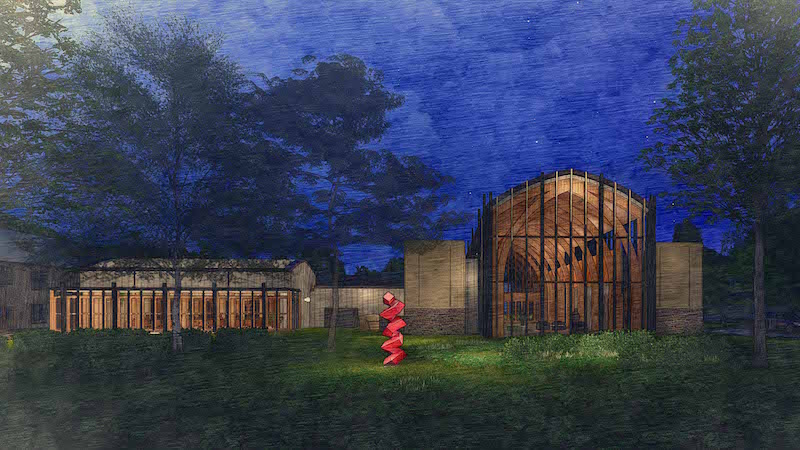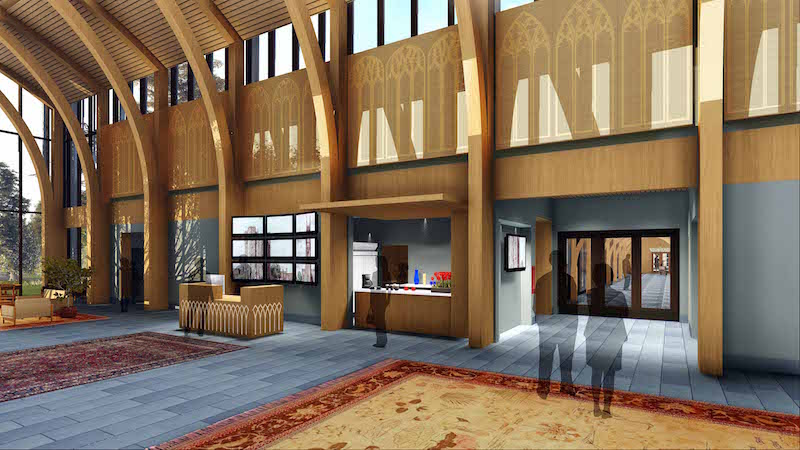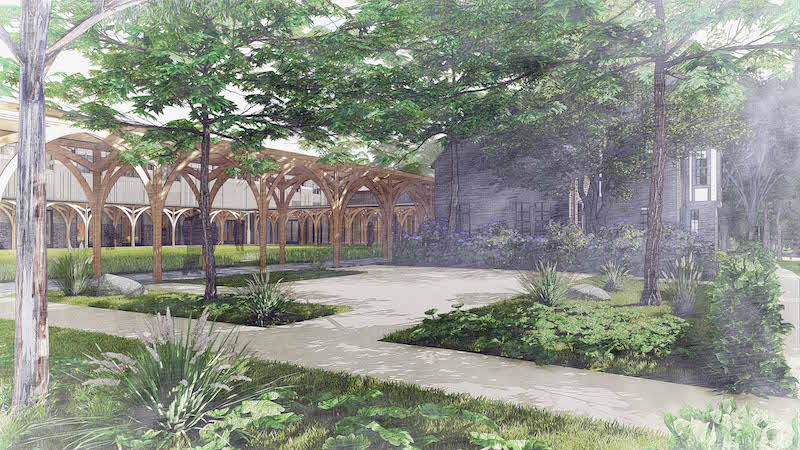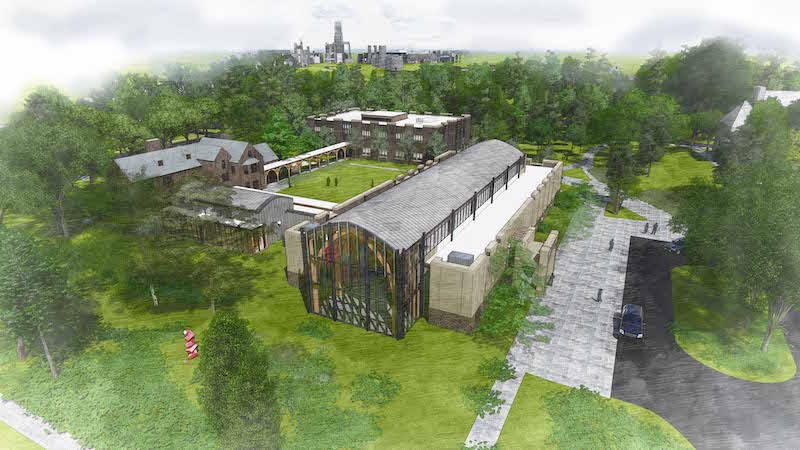The Karsh Alumni and Visitors Center will total almost 47,000 sf across three different buildings on Duke University’s campus. Centerbrook Architects & Planners designed the new complex, which includes event and office space for the Duke Alumni Association and a visitor center.
The largest aspect of the complex is a new 20,200-sf events building with a grand dining and presentation hall, exhibits and lounges, a café, visitor support services, and a smaller meeting pavilion wing. The building is designed to be the first campus stop for returning alumni, prospective students, and visitors. “The striking contemporary glass complements solid walls that hint at Gothic traditions with vertical fenestration, cast stone panels, and a base of locally quarried ‘Duke stone,’ a prominent campus characteristic,” says Mark Simon, FAIA, Centerbrook Principal and Project Architect.
 Rendering courtesy of Centerbrook Architects.
Rendering courtesy of Centerbrook Architects.
The second building is a new 16,900-sf, two-story alumni office meant for staff who support Duke’s alumni and development activities. The third aspect of the project is the renovation of the 7,400-sf Forlines House. This building was part of the original design of Duke’s West Campus that was originally constructed as a private residence for a university leader and used most recently as Duke’s Office of News and Communications. The renovation will remove modifications implemented through the years and restores the original rooms and details on the first floor. The renovations will also enhance the second floor for continued use as executive offices.
 Rendering courtesy of Centerbrook Architects.
Rendering courtesy of Centerbrook Architects.
 Rendering courtesy of Centerbrook Architects.
Rendering courtesy of Centerbrook Architects.
 Rendering courtesy of Centerbrook Architects.
Rendering courtesy of Centerbrook Architects.
Related Stories
| Feb 6, 2012
Siemens gifts Worcester Polytechnic Institute $100,000 for fire protection lab renovation
Siemens support is earmarked for the school’s Fire Protection Engineering Lab, a facility that has been forwarding engineering and other advanced degrees, graduating fire protection engineers since 1979.
| Feb 2, 2012
Fire rated glazing helps historic university preserve its past
When the University embarked on its first major addition since the opening of Hutchins Hall in 1933, preserving the Collegiate Gothic-style architecture was of utmost importance.
| Feb 2, 2012
Next phase of construction begins on Scripps Prebys Cardiovascular Institute
$456 million Institute will be comprehensive heart center for 21st Century.
| Feb 1, 2012
Two new research buildings dedicated at the University of South Carolina
The two buildings add 208,000 square feet of collaborative research space to the campus.
| Jan 31, 2012
Fusion Facilities: 8 reasons to consolidate multiple functions under one roof
‘Fusing’ multiple functions into a single building can make it greater than the sum of its parts. The first in a series on the design and construction of university facilities.
| Jan 27, 2012
BRB Architects designs new campus center for Molloy College
Intended to be the centerpiece of the College’s transformation from a commuter college to a 24-hour learning community, the “Public Square” will support student life with spaces such as a café, lounges, study rooms, student club space, a bookstore and an art gallery.
| Jan 19, 2012
BOKA Powell-designed facility at Texas A&M Bryan campus
The new facility provides programs for the Texas A&M Health Science Center, the Texas Brain and Spine Institute, Mary Crowley Cancer Research Centers, and Blinn College Allied Health programs.
| Jan 4, 2012
Shawmut Design & Construction awarded dorm renovations at Brown University
Construction is scheduled to begin in June 2012, and will be completed by December 2012.
| Jan 3, 2012
New Chicago hospital prepared for pandemic, CBR terror threat
At a cost of $654 million, the 14-story, 830,000-sf medical center, designed by a Perkins+Will team led by design principal Ralph Johnson, FAIA, LEED AP, is distinguished in its ability to handle disasters.
| Dec 20, 2011
Gluckman Mayner Architects releases design for Syracuse law building
The design reflects an organizational clarity and professional sophistication that anticipates the user experience of students, faculty, and visitors alike.
















